
|
The world of non-commercial film and A-V |
Events Diary | Search | ||
| The Film and Video Institute | | ||||
The making of It's An Alpaca
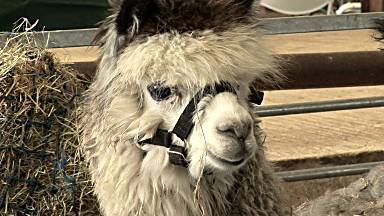 |
One of the most difficult aspects of documentary film making
is identifying suitable subjects.
There are a number of criteria that I regard as being essential for a project to be successful and first and foremost must be my own interest in the chosen subject. If I don't feel inspired by the possibilities there is little prospect of my being able to create a piece that would capture the attention of an audience and, equally important, hold it throughout. There also has to be the potential for capturing visually interesting images which, combined with the sound track, would provide the material for creative and effective editing. I would also say that there are practical considerations which have to pass muster before I can embark on the project. |
The events comprising the action have to be readily available and allow frequent and repeated visits. Single handed documentary film making is a lengthy process involving a great deal of effort and thought and I cannot accomplish this quickly. I would find it impossible to make a satisfactory film on events occurring on a single day. Many do manage this and they have my admiration.
In order to obtain material that would cut properly many different camera angles have to be employed to allow sufficient 'cover' and it is only by repeatedly visiting the location that I can achieve this and at the same time gain the necessary knowledge of the subject to enable me to anticipate the requirements. Other factors such as accessibility, available light, space in which to work, absence of distracting noise (this can often be overcome in post production) and finally, and most important, the permission and co-operation of the people I am filming.
Bearing all this in mind I happened to meet two ladies, Miranda Curtis
and Mandy Wilson, whilst on holiday on a tiny Caribbean island
and on enquiring what they did back home I learned that they farmed alpacas.
My interest was immediately aroused since most people (at that point me included)
know very little about these delightful creatures. I was confident that visually
there would be plenty of scope (there usually is with animals and children!).
The farmers themselves were interesting and would be good on camera and were
receptive to my enquiries. Furthermore the farm was within one and a half
hours drive from my home in North London. Having met them in February I was
at their farm just outside Oxford by late March!
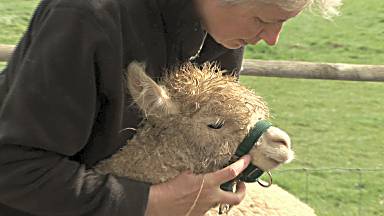 |
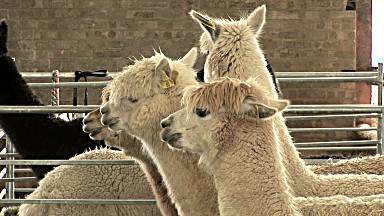 |
I had to conduct my research by observation initially but the major source of of information were the long conversations I had with Mandy and which I filmed. Not only was I obtaining the framework of my story but the raw material of my narration track. Natural speech obtained thus is, for me, far preferable to a formally delivered narration read from a script and is invariably the way I build all the narrations and links for my documentaries. I obtain this spoken material long before I complete the shooting so that I have a clearer idea as to what I need to film. I prefer to film these conversations since there is then the opportunity of cutting between action 'in the field' and the narrator thus ensuring that the audio cuts are seamless and in sync with the picture when I want to return to the 'talking head'.
I planned this film to run pretty well in sequence with events as they occurred from March to late August. In consultation with Mandy and Miranda I was able to plan filming of significant events from toenail trimming and halter training to showing (competitively), shearing, mating and birthing. I was obtaining far more material than I could possibly incorporate into one film but this is common to all documentary film making. You have to film anything that you consider might be in the remotest way useful because once you are in your edit suite on a dark winter evening there is no chance of going back for more! Moreover the structure and storyline only then begins to take shape and I like to have plenty of material from which to choose.
In constructing music sequences, of which this film has at least four, I always need a vast selection of odd little shots for matching the music and I might need dozens of twenty-frame cuts, each using visuals that may not appear anywhere else in the film.
So the year progressed and I filmed and recorded. The action was often
unpredictable so I had to be on my toes and was not always able to utilise
the camera tripod which is not satisfactory but inevitable with this type
of project. With my new Sony HDV Z1 camera I was finding focussing in a hurry
much more difficult than it had been with my previous DVCAM DSR 300 with
its professional high resolution finder and I often had to resort to using
auto focus, something I had never done in forty years of film making!
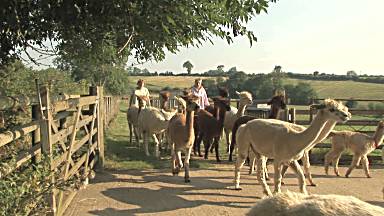 |
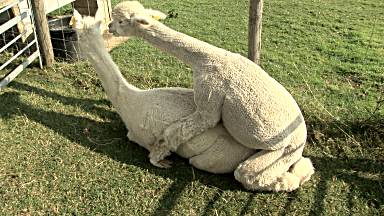 |
The big agricultural shows into which the alpacas were entered provided good material, particularly visual. Audio was not so easy and although I recorded commentary from the PA system the quality was variable. As I needed to continue filming I set one microphone near a PA loudspeaker for one of my camera audio inputs. To avoid trailing cables (quite impossible in these circumstances) I used a radio mic but there was often interference since I was straying out of radio range on occasions. Although 'our' alpacas did quite well in competition it was galling for me to learn that the following year they won everything - Supreme Champion - the lot!
Back at the farm mating and shearing provided great material and I was reminded of a film I made twenty years ago on sheep shearing during a frenetic two months of an English summer. All the same principles and techniques were employed but I was then using 16mm film and faced many more problems with audio sync and editing. I like to think that we were 'proper film makers' in those days!
It was the birthing sequence that gave the most trouble. Animals are unpredictable and alpacas are no exception. Although it was known when births were expected the inaccuracy of these predictions was unnerving to say the least. I had determined to record a birth and there were about twenty due from June onwards.
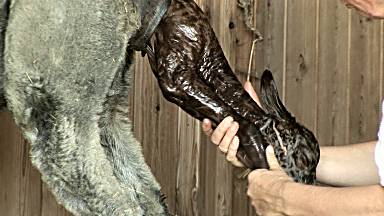 |
I was telephoned before six one morning, it was Mandy. "We think one
of them is about to start birthing, do you want to come out?" I was out
of bed and in the car with all my kit (including tapes and charged batteries)
within minutes. Even early in the morning there is always traffic, not to
mention speed cameras and after about one and a quarter hours I arrived at
the farm only to have missed the actual birth by two minutes!
Later in August when I was getting desperate I spent nearly two days sitting on an upturned bucket in the middle of a field waiting for Diana to disgorge her baby. It required the reassuring visit of a vet before she finally obliged. She had retreated to the field shelter to have the baby which rather disappointed me because most alpacas birth in the open and I would have preferred using a long lens in the open to dramatise the action but on the other hand the audio was better in the confines of the shed. |
As I reviewed my footage gathered over the months I was quite satisfied but at the same time dismayed by the quantity. Decisions had to be made as to whether the film was to be a technical document on how to farm alpacas or a more personal impressionistic piece. I had seen a short commercial film intended for prospective alpaca owners and it contained much of the material that I had but employed a much more formal approach with a competent but but rather stilted narration. This highlighted for me the difference between our freedom to 'do our own thing' and the more disciplined requirements of the commercial world. We do however have to be careful to avoid self indulgence, an accusation often directed at me!
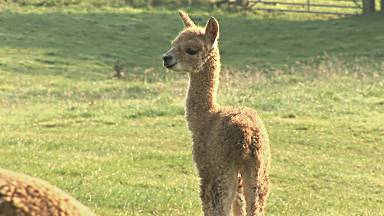 I wanted my film to adopt a personal approach, showing details
of the farming but focussing on the relationship between the two farmers
and their animals. Fortunately I had captured some interesting (and provocative!)
dialogue and as expected Mandy and Miranda came over well on camera. As I
often do I relied on music a great deal to create the mood for a given sequence
and in order to cover a lot of ground in a short time I inserted some quickly
cut music and picture montages. Choosing and obtaining the right music is
vital in such instances and it is something to which I have devoted a great
deal of care and attention throughout my years of film making.
I wanted my film to adopt a personal approach, showing details
of the farming but focussing on the relationship between the two farmers
and their animals. Fortunately I had captured some interesting (and provocative!)
dialogue and as expected Mandy and Miranda came over well on camera. As I
often do I relied on music a great deal to create the mood for a given sequence
and in order to cover a lot of ground in a short time I inserted some quickly
cut music and picture montages. Choosing and obtaining the right music is
vital in such instances and it is something to which I have devoted a great
deal of care and attention throughout my years of film making.
Mindful of the increasing legal problems regarding copyright I now avail myself of the services of a company created in order to obviate these difficulties, Audio Networks plc. They provide specially written music, often by famous names in the music business, for makers of commercials and such. They have a large library of over one hundred CD's to which they continually add. I can clear worldwide any music I use for a given production for one reasonable fee. Their catalogue is cleverly designed to assist an editor in finding the music and musical effects required including percussion, and they provide different length versions with well defined endings.
I had always planned to open the film with a question posed by an off screen voice to passers by on the street, hoping to get some ridiculous answers in order to set a light hearted tone. In the event the answers were not outrageous but sufficed. The question is asked just once (over a blank screen) but we don't see the picture of an alpaca presented with the question. I selected a number of answers and then show the picture and we are into the title and the action.
In accordance with my usual practice I produce a number of rough cuts to show to selected people on a big screen in order to judge reactions and also to look again at the pacing, colour grading and audio balance. I can get a better feel for these aspects viewing this way than in the edit suite. The film was so popular that I was persuaded not to shorten it despite my feelings telling me that I would be in trouble with some festivals.
| Twenty nine minutes is long but I did not want to compromise the overall
effect merely to adhere to artificially designated time constraints. It is
a fact that words occupy more space on a timeline than pictures and editors
face a constant battle in compressing verbal information.
By an odd coincidence I was able to show the finished film on the very same Caribbean island where the idea was born three years earlier. It was projected on to a large screen to an audience in the open night air including the two ladies who made it all possible! They were delighted and now want one hundred DVD's for advertising purposes. I hope that you, dear readers, have had the chance to see the film and if you want a copy just contact me through the forum on this website, using the private mail facility. Any comments, no matter how they are phrased, would be welcomed. I have deliberately not dwelt on the technical details involved in the production because they are mostly mundane but if you have any queries please let me know. - Michael Slowe |
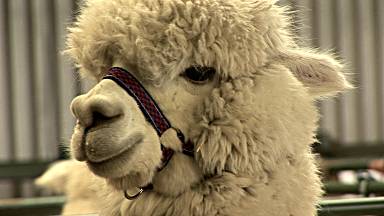 |
Share your passions.

Share your stories.